Category: Cardiology
Keywords: Bundle branch block (PubMed Search)
Posted: 9/22/2013 by Semhar Tewelde, MD
Click here to contact Semhar Tewelde, MD
Is RBBB More Indicative of Large Anteroseptal MI?
Strauss DG, Loring Z, Selvester RH, et al. Right, But Not Left, Bundle Branch Block Is Associated With Large Anteroseptal Scar. JACC. Sept 2013; 62(11): 959-967.
Category: Obstetrics & Gynecology
Keywords: Morning Sickness, Pregnancy (PubMed Search)
Posted: 9/21/2013 by Michael Bond, MD
Click here to contact Michael Bond, MD
Treatment:
Consider these therapies the next time you see a pregnant with persistent nausea and vomiting in her 1st
--Yemi
Niebyl, Jennifer MD. Nausea and Vomiting in Pregnancy. The New England Journal of Medicine. Oct 2010. 363:16.
Category: Pediatrics
Keywords: orthopedics, compartment syndrome (PubMed Search)
Posted: 9/20/2013 by Jenny Guyther, MD
(Updated: 12/6/2025)
Click here to contact Jenny Guyther, MD
We have learned how to diagnose compartment syndrome in adults, but how do you determine the early warning signs in a nonverbal or even frightened child?
Rising compartment pressures are related to increasing anxiety and agitation in children. A Boston study in 2001 showed that increasing pain medication requirements were detected 7 hours earlier than a vascular exam change. 90% of the patients with compartment syndrome in this study reported pain, but only 70% had another ‘P” (pallor, parasthesia, paralysis or pulselessness).
This has led to the proposal of the 3 “A”s for early identification of compartment syndrome in children: increasing anxiety, agitation and analgesia requirement.
Noonan and McCarthy. Compartment Syndrome in Pediatric Patients. Journal of Pediatric Orthopedics. Vol 30. No 2. March 2010.
Category: International EM
Posted: 9/18/2013 by Walid Hammad, MD, MBChB
Click here to contact Walid Hammad, MD, MBChB
General Information:
· The coming of the Affordable Care Act (ACA) is designed to shift patient care from episodic encounters to continuous community based partnerships.
· Elsewhere in the world, community health workers (CHWs) have been used effectively to improve health outcomes, reduce heath care costs and create jobs in infectious disease (TB, HIV), maternal child health and chronic disease management.
· CHWs are paid, full time lay provider members of community health systems.
o Sub-Saharan Africa is training, deploying and integrating one million CHWs into the health system via a targeted campaign.
o Brazil’s CHWs are part of family health teams that care for 110 million people.
o India employs 600,000 CHWs paid through a fee-for-service system for primary care functions.
· CHWs cost less, reduce readmissions and help address root causes of preventable chronic disease while remaining embedded in the community helping to strengthen long-term community relationships.
Relevance to the EM Physician:
As frustration with non-compliant patients mounts and the impact of the ACA looms, CHWs integrated into American communities may be just the answer we haven’t yet considered to help reduce ED overcrowding and improve our patients’ outcomes.
University of Maryland Section of Global Emergency Health
Author: Emilie J.B. Calvello, MD, MPH
Singh,P. Chokshi, D. Community Health Workers – A Local Solution to a Global Problem. NEJM. 2013, 369: 894 – 896.
Category: Critical Care
Posted: 9/17/2013 by Mike Winters, MBA, MD
(Updated: 12/6/2025)
Click here to contact Mike Winters, MBA, MD
Peri-Intubation Cardiac Arrest
Heffner AC, Swords DS, Neale MN, Jones AE. Incidence and factors associated with cardiac arrest complicating emergency airway management. Resuscitation 2013. [Epub ahead of print].
Category: Visual Diagnosis
Posted: 9/16/2013 by Haney Mallemat, MD
Click here to contact Haney Mallemat, MD
8 year-old girl presents with dysphagia and drooling, Xray is shown. What’s the diagnosis (and where is it located)?
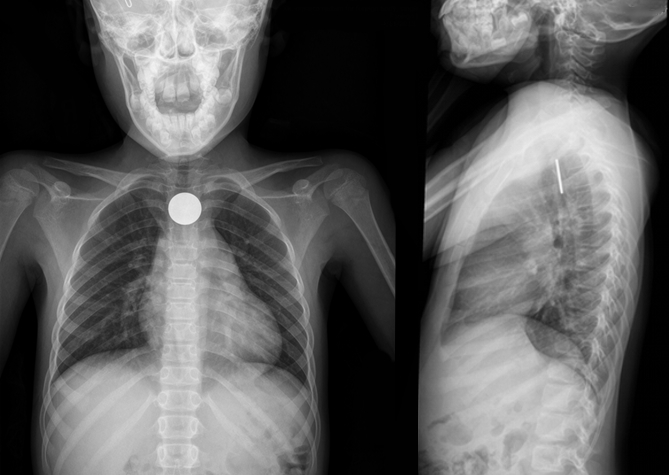
A coin located in the esophagus at the level of the cricopharyneus muscle
Foreign body (FB) pearls
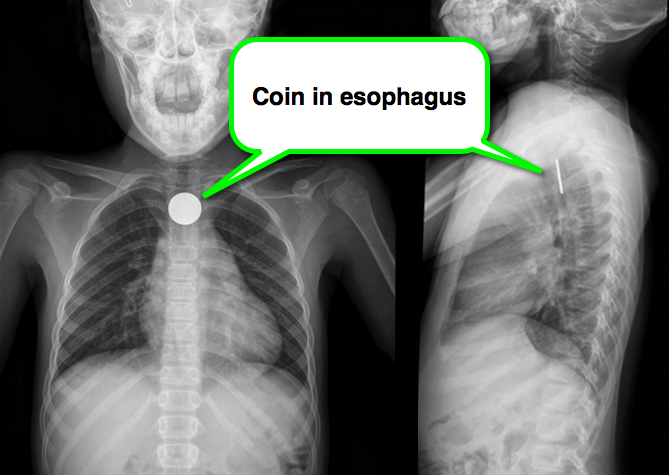
Kenton, Foreign Bodies in the Gastrointestinal Tract and Anorectal Emergencies, Emerg Med Clin N Am 29 (2011) 369–400
Category: Cardiology
Keywords: Acute Pericarditis, Colchicine (PubMed Search)
Posted: 9/15/2013 by Ali Farzad, MD
(Updated: 3/10/2014)
Click here to contact Ali Farzad, MD
Colchicine is known to be effective in treatment of recurrent pericarditis, but until recently its efficacy during the first attack of acute pericarditis has been uncertain.
A recent multicenter, double-blinded, RCT of patients with acute pericarditis found colchicine to be effective in reducing the rate of incessant or recurrent pericarditis (primary outcome), as well as the rate of hospitalization. Here are some highlights:
Bottom-line:
Colchicine is a safe and effective drug for the treatment of acute pericarditis. Consider adding colchicine to conventional therapies to reduce duration of symptoms, recurrences, and rate of hospitalization.
Imazio M, Brucato A, Cemin R, et al. A Randomized Trial of Colchicine for Acute Pericarditis. N Engl J Med. 2013 (.pdf attached)
Do you know the ECG findings of pericarditis and how to differentiate from other causes of diffuse ST-segment elevation? Check out these previous ECG videos to refresh your memory...
STEMI vs. Benign early repolarization vs. Pericarditis
Category: Orthopedics
Keywords: Basilar joint, thumb, arthritis, Basal joint grind test (PubMed Search)
Posted: 9/14/2013 by Brian Corwell, MD
Click here to contact Brian Corwell, MD
The thumb MCP joint is subject to arthritric changes.
Sx's of arthritis will frequently present with pain in a similar region to deQuervain's disease.
The basal joint grind test
Perform by stabilizing the triquetrum with your thumb and index finger and then dorsally subluxing the thumb metacarpal on the trapezium while providing compressive force with the opposite hand.
http://www.youtube.com/watch?v=oEJH7KFGx_Y
Category: Airway Management
Posted: 9/13/2013 by Rose Chasm, MD
(Updated: 12/6/2025)
Click here to contact Rose Chasm, MD
2012 PREP Self-Assessment. American Academy of Pediatrics
Category: Toxicology
Keywords: hypoglycemia, overdose, diabetes, antidiabetic (PubMed Search)
Posted: 9/10/2013 by Bryan Hayes, PharmD
(Updated: 9/12/2013)
Click here to contact Bryan Hayes, PharmD
With several new diabetes medications available, it is important to know which ones are likely to cause hypoglycemia after overdose. Based on mechanism of action and reported cases, the likelihood of hypoglycemia after overdose is listed below by drug class.
Keep in mind that other drugs can interact with antidiabetics resulting in hypoglycemia. This table applies only to single agent ingestion/administration.
| Drug Class | Examples | Hypoglycemic Potential |
|---|---|---|
| Insulins | Glargine, Aspart, Detemir | High |
| Sulfonylureas | Glyburide, Glipizide | High |
| Meglitinides | Nateglinide, Repaglinide | High |
| Glucagon-Like Peptide-1 (GLP-1) Receptor Agonists | Exenatide | Low-Moderate |
| Alpha-glucosidase inhibitors | Acarbose, Miglitol | Low |
| Thiazolidinediones | Rosiglitazone, Piaglitazone | Low |
| Biguanides | Metformin | Low |
| Dipeptidyl Peptidase 4 (DPP-4) Inhibitors | Sitagliptin, Saxagliptin | Low |
Bosse GM. Chapter 48. Antidiabetics and Hypoglycemics. In: Bosse GM, ed. Goldfrank's Toxicologic Emergencies. 9th ed. New York: McGraw-Hill; 2011. http://www.accesspharmacy.com/content.aspx?aID=6514172. Accessed September 10, 2013.
Follow me on Twitter (@PharmERToxGuy)
Category: International EM
Keywords: climate, infectious, globalization, population, disease (PubMed Search)
Posted: 9/11/2013 by Andrea Tenner, MD
Click here to contact Andrea Tenner, MD
Background Information:
A recent review article in NEJM evaluated what effects globalization and climate change can be expected to have on human health. If global population increases and temperatures continue to rise, diseases that were once limited by either remoteness or climatologic regions may have new geographical spread.
Pertinent Conclusions:
There are three primary ways which climate change may be expected to affect health:
- Primary: Direct biologic consequences (i.e. heat waves, extreme weather events, air pollution)
- Secondary: Risks caused by process changes (i.e. decreased crop yields, tropical vectors with increased spread)
-Tertiary: More diffuse effects (mental health issues in failed farmers, conflict due to scarce water)
Bottom Line:
No matter what your views are on the causes, the current trend is that the overall climate is getting warmer and human population is increasing. Anticipation of possible consequences is key to planning for the future.
University of Maryland Section of Global Emergency Health
Author: Andi Tenner, MD, MPH
McMichael AJ. Globalization, Climate Change, and Human Health. N Engl J Med 2013; 368:1335-1343.
Category: Critical Care
Keywords: critical care, necrotizing pneumonia, infectious disease, pulmonary (PubMed Search)
Posted: 9/5/2013 by John Greenwood, MD
(Updated: 9/10/2013)
Click here to contact John Greenwood, MD
Necrotizing Pneumonia
Necrotizing pneumonia is a rare, but potentially deadly complication of bacterial pneumonia.
It is characterized by the finding of pneumonic consolidation with multiple areas of necrosis within the lung parenchyma. Necrotic foci may coalesce, resulting in a localized lung abscess, or pulmonary gangrene if involving an entire lobe.
Most common pathogens: S. aureus, S. pneumoniae, and Klebsiella pneumonia.
Others include S. epidermidis, E. coli, Acinetobacter baumannii, H. influenzae and Pseudomonas.
Contrast-enhanced chest CT is the diagnostic test of choice and is also helpful in evaluating for parenchymal complications.
Empiric antibiotic therapy should include:
Consider an early surgical evaluation for the patient with necrotizing pneumonia complicated by septic shock, empyema, bronchopleural fistula, or hemoptysis.
Reference
Tsai YF, Ku YH. Necrotizing pneumonia: a rare complication of pneumonia requiring special consideration. Curr Opin Pulm Med. 2012 May; 18(3):246-52.
Category: Visual Diagnosis
Posted: 9/8/2013 by Haney Mallemat, MD
(Updated: 9/9/2013)
Click here to contact Haney Mallemat, MD
This week's case is challenging, but very interesting...
An elderly patient presents with a history of significant weight loss and chronic constipation; abdominal Xray is below. What's the diagnosis? (Hint: why is the right kidney and psoas muscle so well defined?)
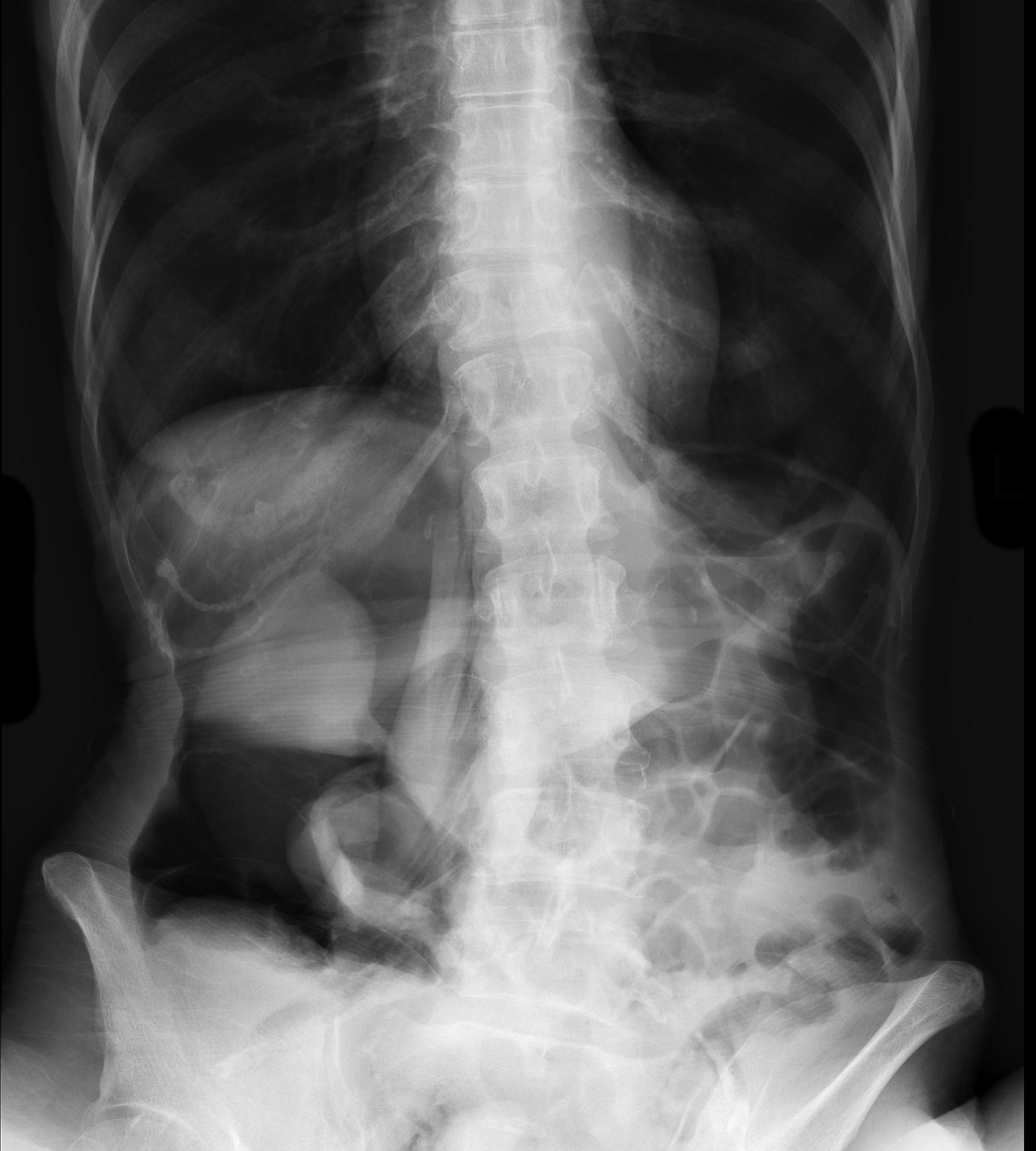
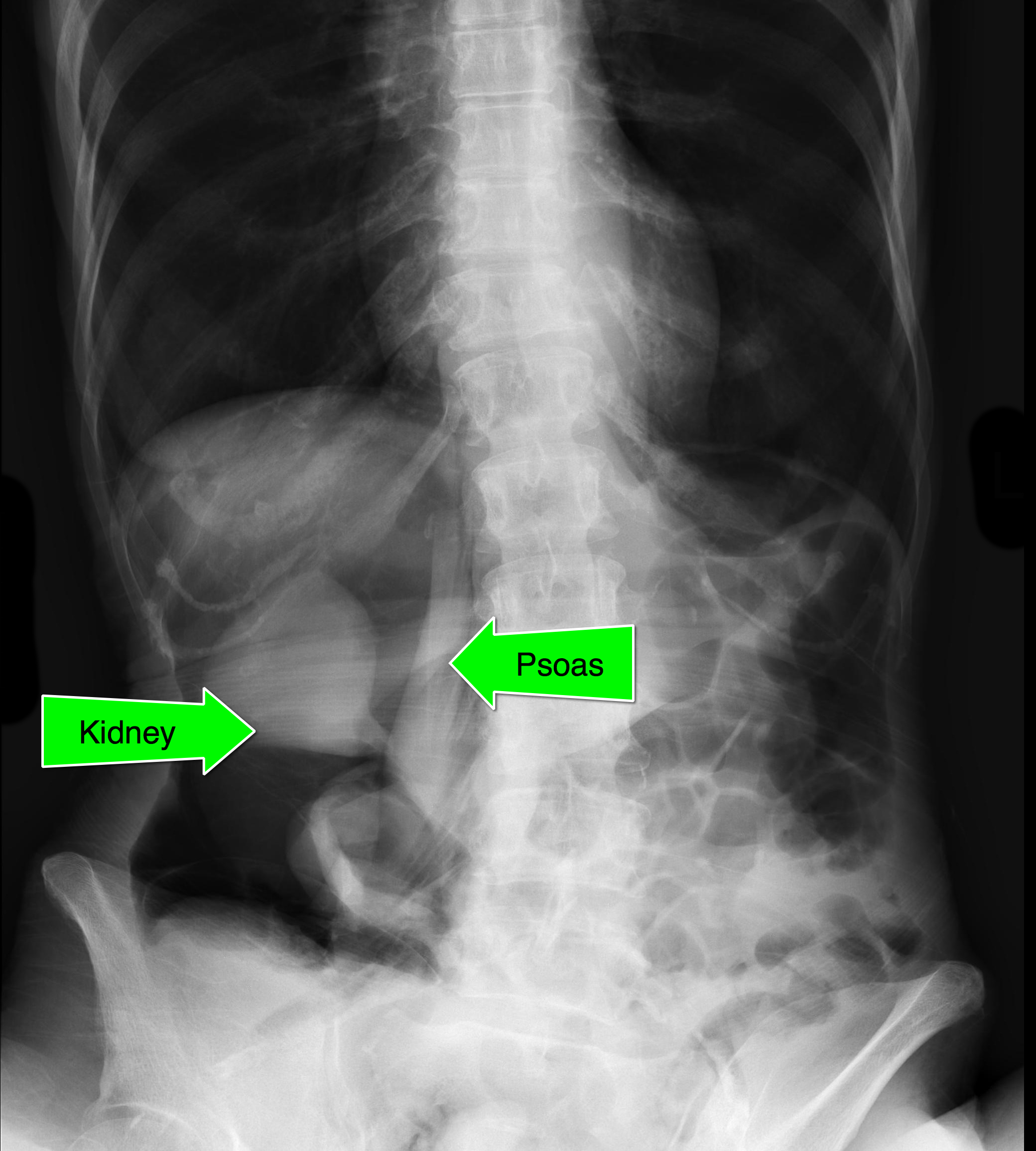
Follow me on Twitter (@criticalcarenow) or Google+ (+criticalcarenow)
Category: Cardiology
Posted: 9/8/2013 by Semhar Tewelde, MD
Click here to contact Semhar Tewelde, MD
*Please see the attachment below for Figures A-D
1. Adler A, Rosso R, Viskin D, et al. JACC. Sept. 2013: Vol. 62(10) pgs. 863-868
2. Haissaguerre M., Derval N., Sacher F., et al: Sudden cardiac arrest associated with early repolarization. N Engl J Med 2008; 358: 2016-2023
3. Tikkanen J.T., Anttonen O., Junttila M.J., et al: Long-term outcome associated with early repolarization on electrocardiography. N Engl J Med 2009; 361: 2529-2537
Category: Pharmacology & Therapeutics
Keywords: antibiotic, obese, obesity, critically ill, antimicrobial (PubMed Search)
Posted: 8/31/2013 by Bryan Hayes, PharmD
(Updated: 9/7/2013)
Click here to contact Bryan Hayes, PharmD
Although there is a paucity of data to guide dosing of antimicrobials in the critically ill obese patient, we can draw some conclusions from existing kinetic studies. Assuming normal renal and hepatic function, here's what to do:
Penicillins: Use the high end of dosing range. For example, if the plan is to use piperacillin/tazobactam 3.375 gm IV every 6 hours for a complicated intra-abdominal infection, use 4.5 gm instead.
Cephalosporins: Use the high end of the dosing range.
Carbapenems: Use the high end of the dosing range.
Quinolones: Use the high end of the dosing range.
Aminoglycosides: Dose using adjusted body weight. ABW (kg) = IBW + 0.4 X (actual body weight - IBW)
Vancomycin: 15-20 mg/kg actual body weight every 8 to 12 hours. Adjust based on trough level.
When dosing most antibiotics in critically ill obese patients, use the high end of the dosing range (if not more).
Erstad BL. Dosing of medications in morbidly obese patients in the intensive care unit setting. Intensive Care Med 2004;30(1):18-32. [PMID 14625670]
Medico CJ, Walsh P. Pharmacotherapy in the critical ill obese patient. Crit Care Clin 2010;26(4):679-88. [PMID 20970057]
Follow me on Twitter (@PharmERToxGuy)
Category: Airway Management
Keywords: NMS, haldol, haloperidol, fluphenazine, dantrolene, bromocriptine, diazepam (PubMed Search)
Posted: 9/5/2013 by Ellen Lemkin, MD, PharmD
Click here to contact Ellen Lemkin, MD, PharmD
NMS is most often seen with the typical high potency neuroleptic agents (e.g haldol, fluphenazine)
All classes of antipsychotics can cause NMS, including low potency and newer atypical agents; antiemetics can cause this as well.
Symptoms usually occur after the first 2 weeks of therapy, but may occur after years of use
Signs and symptoms include:
mental status changes
muscular rigidity (“lead pipe”)
hyperthermia (>38 - 40 degrees).
Autonomic instability (tachycardia, tachycardia and diaphoresis)
Treatment includes discontinuation of the offending agent and providing supportive care.
While no clinical trials have ever been undertaken, dantrolene (muscle relaxant) is commonly used.
Bromocriptine (dopamine agonist) may also be used, and amantadine (dopaminergic and anticholinergic agent) is used as an alternative to bromocriptone
Recently, several case reports have documented the successful use of diazepam as a sole pharmacologic agent. This may be an alternative or a supplement to the above agents
Category: Critical Care
Posted: 9/3/2013 by Haney Mallemat, MD
Click here to contact Haney Mallemat, MD
UEDVT comprise 10% of all DVTs (majority are lower extremity), but incidence of UEDVT is rising; UEDVTs are categorized into distal (veins distal to axillary vein) or proximal (from superior vena cava to axillary vein)
Compared to lower extremity DVT, UEDVTs have lower:
75% of UEDVT are secondary (indwelling catheters, pacemakers, malignancy, etc.) and 25% are primary in nature; #1 primary cause of UEDVT is Paget – Schroetter disease
Up to 25% of patients with primary UEDVTs are eventually found to have an underlying malignancy; patients with idiopathic UEDVT should be referred for cancer workup
Treatment includes removal of the catheter (if no longer needed) and:
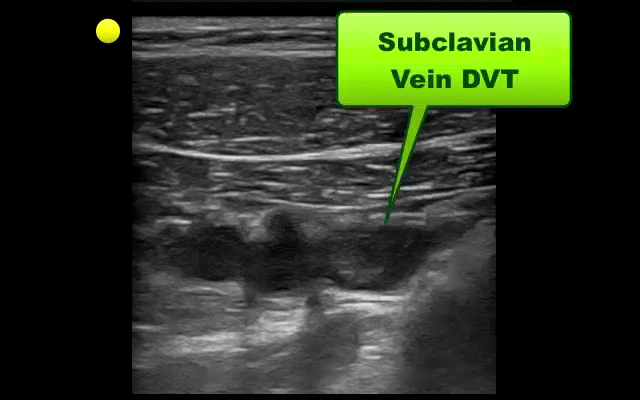
Follow me on Twitter (@criticalcarenow) or Google+ (+criticalcarenow)
Category: Visual Diagnosis
Posted: 9/2/2013 by Haney Mallemat, MD
Click here to contact Haney Mallemat, MD
Elderly male presents with headache, confusion, and trouble with gait. What's in your differential diagnosis?
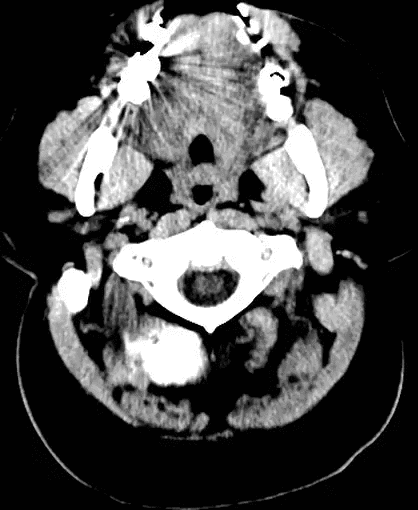
Based on the CT scan shown, the differential here includes epidermoid and arachnoid cyst
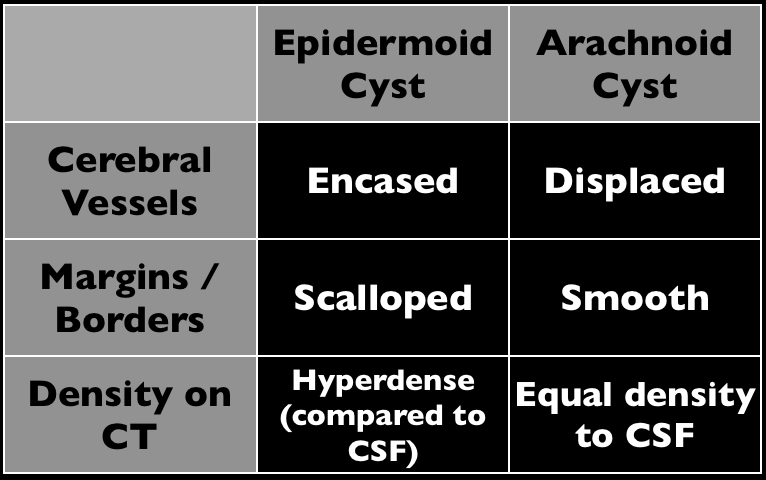
Arachnoid cysts (AC) occur within the cerebrospinal axis and do not communicate with the ventricular system. Most occur in the middle cranial fossa and are typically benign; continuing cerebrospinal fluid
The majority of AC occurs from abnormalities in development, but a small portion occurs secondary to post-surgical adhesions or in association with cancer.
MRI is the test of choice to help define the extent of the cyst as well as determine alternative diagnoses.
Treatment is variable with some experts stating that only symptomatic ACs should be treated with others recommending removal to avoid future complications.
The patient in the stem presented with symptoms secondary to complications from the AC.
Follow me on Twitter (@criticalcarenow) or Google+ (+criticalcarenow)
Category: Cardiology
Keywords: Hypertension (PubMed Search)
Posted: 9/1/2013 by Ali Farzad, MD
(Updated: 3/10/2014)
Click here to contact Ali Farzad, MD
Adult ED patients are commonly found to have markedly elevated blood pressures (>160/100) without any signs or symptoms of acute organ injury (ie, cardiovascular, renal, or neurological).
A recently revised ACEP clinical policy aims to guide emergency physicians in the evaluation and management of such patients.
They make the following recommendations (Level C):
Bottom-line:
There's little evidence to guide the decision of which patients with markedly elevated blood pressures to test or treat in the ED. This new clinical policy suggests that routine screening and treatment is not required. Asymptomatic patients should be referred for close follow-up, but consider a BMP in patients with poor follow up.
Want more emergency cardiology pearls? Follow me @alifarzadmd
Wolf SJ, Lo B, Shih RD, et al. Clinical Policy: Critical Issues in the Evaluation and Management of Adult Patients in the Emergency Department with Asymptomatic Elevated Blood Pressure. Ann Emerg Med. 2013;62(1):59–68.
Category: Toxicology
Keywords: flecainide, overdose, sodium channel (PubMed Search)
Posted: 8/29/2013 by Fermin Barrueto
Click here to contact Fermin Barrueto
There are Type 1C Anti-Dysrhythmics, like propafenone and flecainide, that are utilized to suppress atrial fibrillation. They are called Type 1C due to their sodium channel blocking effects. Flecainide has a potent effect on the ECG and has caused significant and resistant widening of the QRS complex.
Typically, a sodium channel blocker like a TCA can be treated with hypertonic sodium bicarbonate but flecainide has been resistant to this at times and there is a reported overdose utilizing magnesium sulfate. (1) Keep that in mind if you were to see a widened QRS complex in the face of a flecainide ingestion.
There has been a Brugada ECG pattern also reported (I know Amal is smiling) (2) ontop of the widened QRS, PR intervals though minimal effect on the QT.
1: Cabrera Ortega M, Gell Aboy J, Díaz Berto E, Monagas Docasal V. [Acute flecainide overdose]. An Pediatr (Barc). 2011 Jan;74(1):56-8. 2: Martínez-Mateo V, Arias MA, Rodríguez-Padial L. [Brugada electrocardiographic pattern elicited by flecainide overdose]. Med Clin (Barc). 2011 Mar 19;136(7):320.
